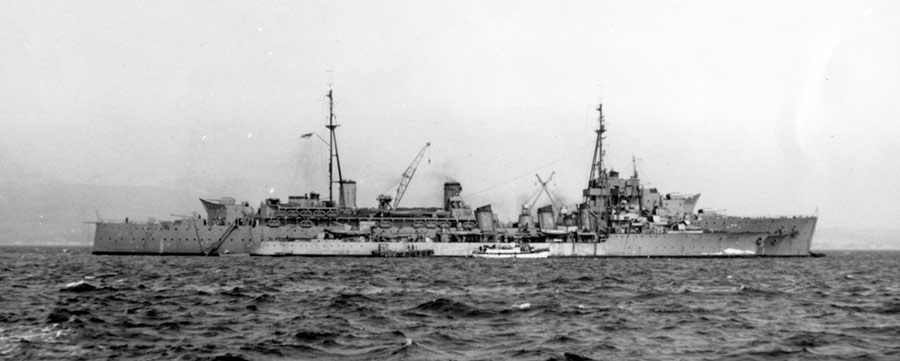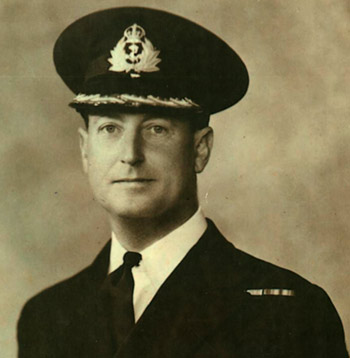






Arthur Ching described his memories of HMS Hecla in a long letter he wrote from his home in Plymouth to Isobel Margerrison in Glencairn, Simon's Town, on the 26 February 1979. Her husband, John Edward Margerrison, known as Joss, was the Captain of HM Tug Dogmael which assisted HMS Hecla into harbour at Simon's Town after the mining.
Arthur Ching was their guest on several occasions and got to know the
family well. Audrey was the Margerrison's daughter who helped in the
Simon's Town Museum when she was older. "Hildasime" was a hotel at Sea
Point owned by an aunt of Joss Margerrison. "Brownie" is Chief
Petty Officer Norman Brown SB who was killed when Hecla
sank. He was stationed at the Simon's Town Hospital in the 1930s and
became a friend of Mrs Margerrison and her husband. "Brownie" was
a distant cousin of Arthur Ching. All of this was explained to me by
Audrey Read, the Margerrison's daughter, and Kenneth Brown the son of Norman Brown who was 13 when his father died. I would
also like to acknowledge the assistance of Margaret Constant of the
Simon's Town Museum who sent me scans of Arthur Ching's letter.
 "I joined the Hecla
in Glasgow early in April 1942. She was in dry dock, nearly all the
ship's company were on leave. I surmised that we were bound for distant
parts! We joined a convoy of ships at the Tail of the Bank, which is at
the mouth of the River Clyde, in mid April. We then sailed Westward to
the mid Atlantic, then South, arriving at Freetown, West Africa, where
we stayed for a few days, refuelling, taking on stores, relaxing for a
few hours on the beach and, incidentally, meeting my younger brother,
Howard, who was serving aboard HMS Philoctetes, the base ship which, as
I remember, was not a very happy ship. On leaving Freetown, we headed
south towards the Cape. We had the usual crossing the line ceremony,
which employed the talents of “Brownie” who wrote up the certificates
of many of us in old English script, which subsequently earned him a
large hangover!
"I joined the Hecla
in Glasgow early in April 1942. She was in dry dock, nearly all the
ship's company were on leave. I surmised that we were bound for distant
parts! We joined a convoy of ships at the Tail of the Bank, which is at
the mouth of the River Clyde, in mid April. We then sailed Westward to
the mid Atlantic, then South, arriving at Freetown, West Africa, where
we stayed for a few days, refuelling, taking on stores, relaxing for a
few hours on the beach and, incidentally, meeting my younger brother,
Howard, who was serving aboard HMS Philoctetes, the base ship which, as
I remember, was not a very happy ship. On leaving Freetown, we headed
south towards the Cape. We had the usual crossing the line ceremony,
which employed the talents of “Brownie” who wrote up the certificates
of many of us in old English script, which subsequently earned him a
large hangover!
We were rounding the Cape of Good Hope on a lovely sunny afternoon
while I was sitting in the mess, had just finished tea and about to
light a cigarette when there was a loud explosion, smoke and
flame. We all raced to the upper deck. The ship had stopped but
everything was quite calm, the sea, the people, etc. We set about
ascertaining the extent of the damage (caused by a mine); there were
twenty-four killed and approximately two hundred and forty injured. The
medical staff, doctors etc., were marvellous, they worked throughout
the night as we steamed towards Simon's Town, where we arrived in the
early hours and dropped anchor, subsequently docking and spending six
months under repair.
One of the sad events, which I supervised was the preparation for
burial at sea of our late shipmates; the ceremony was performed by the
cruiser Sirius. Our injured shipmates were accommodated at the naval
hospital where thy all made good recoveries from their various
injuries.
During the six months of our stay, a lot of Hecla’s people, through the
good offices of the Women’s Voluntary
Service enjoyed the hospitality of homes, hotels, farms, etc., it was
all very heart warming. I personally met and made friends who have
endured through the passing years. I remember the Sunday evening, you,
Joss, Brownie and I visiting “Hildasime” for the first time, having
first taken Audrey back to the Star of the Sea Convent. I
remember how the boys tried to manoeuvre the way to the platform to
Simon's Town but you quietly insisted on catching the Cape Town train;
and the visit when we first met Mrs Hopwood; it was just one of those
pleasant days we spent with you during our sojourn in South Africa. I
remember well the walks to “Boulders”, a very pleasant place and a
favourite of Jose’s, as I remember.

To continue with the story of the Hecla. We completed repairs to the
ship in mid October when we sailed to Saldhana Bay where we got
ourselves organised for future activities, the end of a pleasant
interlude. We went to Cape Town where our new Captain joined us. We
anchored off Simon's Town for some hours while we awaited our sailing
orders, which, to my surprise, meant going back up north through the
Atlantic. We arrived at Freetown on about the 6 November where we
stayed about three days while a convoy formed. We moved out into the
Atlantic and headed north. We saw ships of the American forces the day
after we left port, battleships, cruisers and auxiliary vessels, so we
guessed there was something brewing; it was in fact the opening chapter
of the North Africa landings. We were intended to play a part in that
operation, however, man proposes?
We moved north with two destroyers, HMS Marne and Venomous, as escorts.
On the 11 November, early afternoon, there were reports of U-boat packs
in our vicinity, we continued, apparently shadowed by the U-boats, the
convoy was ordered to disperse after dark, to minimise the targets for
the U boats. At 11 pm on the 11 November 1942 Hecla was struck by the
first of five torpedoes, in a boiler room beneath the sick Bay where
Brownie and I were sleeping, we immediately dressed and got the sick patients to the wardroom ante-room, after
this, two more torpedoes struck the ship, which cut off power to the
boat hoists. The captain gave the orders to "abandon ship", which
necessitated lowering of all the rafts etc with no lights; there was
bound to be some confusion and I believe that some people were struck
by falling life-rafts and sustained fatal injuries. My last sight of
Brownie was in the wardroom prior to "abandon ship". I was a
supernumerary in the ship, a relief for casualties in the fleet, as
such, I didn’t have an abandon ship allocation. I simply walked back to
the stern of the ship and jumped. I swam around for a few hours with a
plank of timber for company. In the interim out two escort destroyers, Marne and Venomous, were trying to track the U-Boats down, stopping
to pick up survivors at intervals. The Marne had her stern blown off by
a torpedo during these rescue bids, so they were of short
duration and speedy.
When dawn came I was in company with fourteen other survivors on a
small Balsa raft, I still kept my plank however. The sole survivor on
the Balsa raft and myself were picked up by Venomous at 1400 hours on 12 November, fourteen hours after leaving Hecla. Venomous steamed into Casablanca harbour with 500 survivors, we were berthed alongside the American cruiser USS Augusta,
where we received medical attention, food, clothing etc. Unfortunately
I was unable to enjoy the food and drink provided, the aftermath of Hecla’s
sinking had covered the sea with fuel oil, which I had unwittingly
partaken of. We spent the night lying on the deck of a hangar on a
fleet auxiliary ship. I can still feel the warmth and luxury of that
hard deck to this day. The following day, the 14 November, we sailed for
Gibraltar; we buried two [should be four] of our number who had died in Casablanca, due
to injuries, en route to Gibraltar. We arrived at Gibraltar on the 15th
where we tied up alongside one of our cruisers, HMS Aurora, where we were well looked after. The next day at 4 am, we were taken on board the battleship Duke of York where they provided us with toilet gear and other creature comforts. Later that day we boarded the P & 0 liner Strathnaver, but after one meal - tea - we left and boarded the liner Reine Del Pacifico.

After a scrumptious dinner and a night's rest, I was sent to join HMS Lowestoft, a sloop which had earlier been rammed by the French cruiser, Leopard. The Lowestoft could only steam at 6 knots and we had to steam her home to Falmouth; our crew comprised forty survivors of Hecla, one hundred from a sloop sunk by air attack in the Mediterranean plus twenty-nine of the Lowestoft’s original crew. Fortunately, as far as I was concerned, Commander D'Oyly of Hecla (on right) was in command; to be turned loose in the Atlantic with the top speed
capability of 6 knots made one feel a little apprehensive, if that is
the right word to use? However, after a few scares, aircraft sightings
and U-Boat alarms we arrived off the Bishop's Rock lighthouse and two
hours later we were tied up alongside in Falmouth Harbour. The day we
returned to the Naval Barracks, we met other survivors of Hecla returning from their survivors leave …
Hecla carried a complement of 800, of which we lost about 300 the night she was torpedoed."